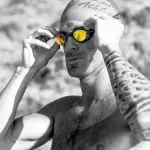To help you visualize what muscles should be firing off during the pull, imagine squeezing a pillow between your upper arm and lats. Keep this in mind as you pull your arm back past your head towards your hips. Same as with the catch, stay smooth and controlled when applying force throughout this motion. If you move too quickly through this pathway, you're likely to feel a slip or loss of traction on the water.
The goal is to pull a nearly linear pathway along the frame of your body. Again, practice with a one-arm freestyle drill—slow your stroke rate and isolate your focus on the pull.
The Push
The push is the final phase of the pull and the most powerful aspect of the freestyle stroke. In an effort to increase turnover (cadence) for open water swimming, many athletes cut the finish of their stroke short, thus creating a shorter or quicker stroke cycle. Unfortunately, untapped power potential is left on the table when doing this.
The push begins once you send your hand backward, past your elbow. Visually, it's the final extension of the arm before your hand exits the water at the back of the stroke. From the beginning of the catch to the finish of the push, it's helpful to imagine progressively building power and speed throughout these three phases.
Continuing the linear pathway along the frame of your body, your hand should exit the water in the middle of your hip. For most, this would be around the bottom of your pocket on a pair of jeans. Allow the outside of your thumb to lightly brush the bottom of your "jeans pocket" each stroke until you've found that sweet spot.
If you're familiar with gym equipment, the final motion of the push is comparable to a tricep pushdown on the cable machine. You're continuing to recruit muscles on the backside of your body, but primarily your triceps. You don't want to hyperextend your arm at the end of the stroke, but rather finish with a micro-bend to the elbow. This will land your hand at the point on your "pocket" that we discussed. This phase of the stroke demands conscious repetition and focus, as it's easy to forget when trying to push the pace in a squad or race environment.
Be patient with yourself as you practice these mechanical changes. Remember, repetition is necessary to ingrain changes in freestyle.
Ready to swim, bike and run? Find your next triathlon here.



